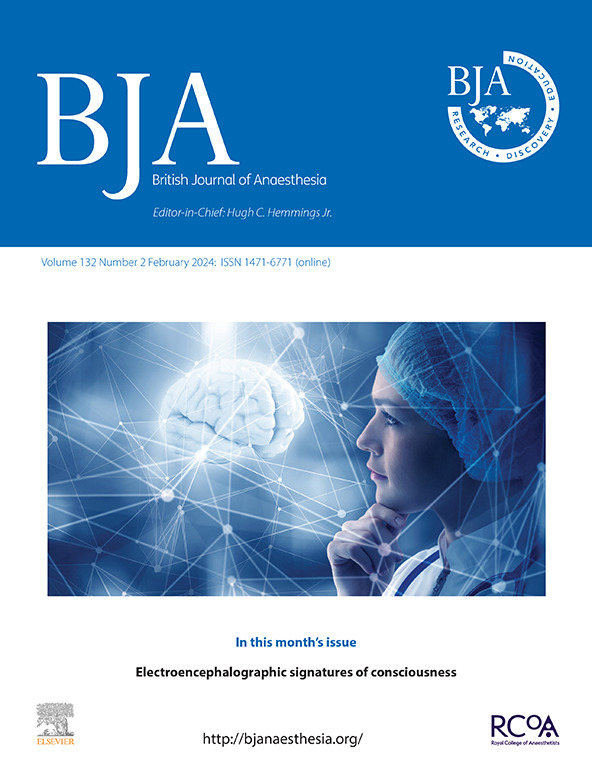Response of the Conox quantitative electroencephalographic monitor to neuromuscular block in awake volunteers.
IF 9.2
1区 医学
Q1 ANESTHESIOLOGY
引用次数: 0
Abstract
BACKGROUND The Conox monitor analyses the frontal EEG to generate two indices of anaesthetic effects: qCON, intended to indicate the level of consciousness, and qNOX, designed to reflect responsiveness to noxious stimuli. Two similar quantitative EEG devices, BIS and Entropy, have been shown to require muscle activity (EMG) to generate accurate index values in awake individuals. Without EMG, these devices produce misleadingly low values and incorrectly suggest sedation or anaesthesia despite the cortical EEG showing the subjects are awake. As EMG affects frequency bands used by Conox, it too could be incorporating muscle activity to generate high values in awake individuals. METHODS We replayed EEGs recorded during awake paralysis to the Conox monitor via an electronic playback system to test whether it requires EMG to generate accurate values in awake subjects. RESULTS Both qCON and qNOX decreased after neuromuscular block to values consistent with sedation or anaesthesia, despite subjects being fully awake. qCON decreased below 60 in 15 of 19 trials, and qNOX decreased below 60 in 11 of 19 trials. Overall, 42% of qCON values during paralysis were <60, the level supposedly indicating anaesthesia. CONCLUSIONS Conox requires muscle activity to generate accurate values in awake individuals. Consequently, it might be an unreliable indicator of awareness in patients who have received neuromuscular blocking drugs. Studies conducted without neuromuscular block can provide misleading guidance when applied to Conox use in paralysed patients. Clinicians should approach manufacturer guidelines with caution and not rely solely on index values to guide dosing of anaesthetic drugs.Conox定量脑电图监测仪对清醒志愿者神经肌肉阻滞的反应。
背景:Conox监测器通过分析额叶脑电图来产生麻醉效果的两个指标:qCON,用来指示意识水平,qNOX,用来反映对有害刺激的反应。两种类似的定量脑电图设备,BIS和Entropy,已被证明需要肌肉活动(EMG)来产生清醒个体的准确指数值。在没有肌电图的情况下,这些装置会产生具有误导性的低值,并错误地提示镇静或麻醉,尽管皮质脑电图显示受试者是清醒的。由于肌电图影响Conox使用的频段,它也可以结合肌肉活动,在清醒的个体中产生高值。方法通过电子重放系统对Conox监护仪重放清醒麻痹时记录的脑电图,测试清醒状态下是否需要肌电图生成准确值。结果神经肌肉阻滞后,qCON和qNOX均下降至镇静或麻醉时的水平,尽管受试者完全清醒。19项试验中有15项qCON降至60以下,19项试验中有11项qNOX降至60以下。总体而言,瘫痪期间42%的qCON值<60,该水平被认为表明处于麻醉状态。结论sconox需要肌肉活动才能在清醒状态下产生准确的数值。因此,对于接受神经肌肉阻断药物的患者来说,它可能是一个不可靠的意识指标。在没有神经肌肉阻滞的情况下进行的研究,在将Conox应用于瘫痪患者时,可能会提供误导性的指导。临床医生应谨慎对待制造商指南,而不是仅仅依靠指标值来指导麻醉药物的剂量。
本文章由计算机程序翻译,如有差异,请以英文原文为准。
求助全文
约1分钟内获得全文
求助全文
来源期刊
CiteScore
13.50
自引率
7.10%
发文量
488
审稿时长
27 days
期刊介绍:
The British Journal of Anaesthesia (BJA) is a prestigious publication that covers a wide range of topics in anaesthesia, critical care medicine, pain medicine, and perioperative medicine. It aims to disseminate high-impact original research, spanning fundamental, translational, and clinical sciences, as well as clinical practice, technology, education, and training. Additionally, the journal features review articles, notable case reports, correspondence, and special articles that appeal to a broader audience.
The BJA is proudly associated with The Royal College of Anaesthetists, The College of Anaesthesiologists of Ireland, and The Hong Kong College of Anaesthesiologists. This partnership provides members of these esteemed institutions with access to not only the BJA but also its sister publication, BJA Education. It is essential to note that both journals maintain their editorial independence.
Overall, the BJA offers a diverse and comprehensive platform for anaesthetists, critical care physicians, pain specialists, and perioperative medicine practitioners to contribute and stay updated with the latest advancements in their respective fields.

 求助内容:
求助内容: 应助结果提醒方式:
应助结果提醒方式:


